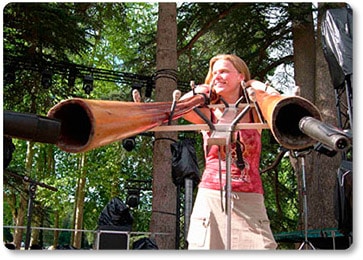So what’s this about women not being allowed to play the didgeridoo?

Here is some information to clarify this topic.
We reckon it is awesome how tracing back as far as documented and known history allows, many musical instruments originated primarily for ceremonial, celebration or spiritual functions.
Also fascinating is how many instruments were developed in some way to resemble, depict or in some reference sexuality. The Guitar was shaped in the form of a woman’s body, the African Drum also, there is much to be said about the Native American Flute and the list goes on. Even amongst the very few Australian Aboriginal groups who actually played the Didgeridoo had phallic considerations for the instrument.
Commonly in traditional nomadic and resident cultures around the world, to ensure the survival of their people, different jobs were allocated to different sexes, ages or bloodlines. If those allocated to hunt for food cared for the children all day then that night the people would go without food, not a good thing! It was all about survival.
The “Dreamtime” an old Aboriginal man once told us, was a necessary intricate group of stories, unique for each group, and massively related to the geography of the nomadic route and survival of the group. He once told us a story about a very dangerous snake shaped water hole. There was only one safe place to enter the water. So the Dreamtime style story mainly for the children, in short, was; A serpent creature lived in this waterhole and he was always hungry to eat people, especially children. The river was shaped like a snake and the only place to be safe was at the “head” end of the water hole. Also any swimmers had to have an uncle stand watch up at a certain sacred watching spot, he would sing a song to ease the hunger of the serpent and stand watch. Swimmers could only enter the water carefully and to a certain depth, as this was safe. Anybody entering the water without the Uncle, song and watch, if they survived the serpent, would be severely punished.
This story was told, because back then there was no pool fences, the water in the watering hole was dark and they did not want the kids to swim unsupervised. So this ritualistic, “Dreamtime” style story keep the children safe at that time of year at that watering hole.
Similar stories were created in areas of rocky outcrops, that different spirits lived amongst the rocks, so to go up into the mountains or on the rocky areas, people had to have certain family or group members present, sing certain songs or offer ceremonial prayers and enter the area quietly and carefully so as to not displease the spirits who lived there. We were told that this story again, was to keep the kids safe. They see rocks and want to run up them, mess around then somebody gets hurt. These stories are all about the survival of those people in those areas.
Stories have been used for a long time to keep people focused on their core business, particularly during work time! Some of these group “stories”, different of course from group to group were regarding the Didgeridoo. Imagine the problems if “Sarah” spent all day playing didgeridoo instead of collecting bush tucker for the group. People would go without eating! So its cool for “Sarah” to play but she must get her job done first. Hard to keep kids and young adults on task so in comes the stories, like “if girls play the Didgeridoo they will get pregnant” or the opposite, “ If girls play the didgeridoo they wont be able to have children”. Or “Girls can’t play because the Didgeridoo is a phallic symbol” I have even heard “If girls play the Didgeridoo they will have twins!” These reasons and stories were often totally different between groups.
The people in each group are allocated different responsibilities. As no written communication or lap tops were available back then, responsibilities and stories had to be handed down by word of mouth and an involved security system of many people contributing many jig saw pieces and checking up to ensure stories, songs and ceremony were accurately passed through the generations.
In the few groups in the far North of Australia who ever used the Didgeridoo for ceremonies, music, playing and story telling, somebody was allocated the custodianship of their Didgeridoo songs. This was allocated basically at birth. Didgeridoo custodian was one of the jobs allocated to boys, men’s business. These future custodians’ would be taught the intricacies of that groups specific Didgeridoo songs and stories during his life until he ultimately became the custodian of the Didgeridoo for the group. Other men and women had different roles, song man, dancers, hunters, lawman, and the like.
Now the fact is, although the Didgeridoo man may not be the lawman, he still knew the law. Likewise the Women who were custodians of certain ceremonial dances were not the song man they still knew the songs. So to, anybody in the group who had different functions, their job was their job and they were the ones responsible to do their job. But outside of that life went on. Singing songs, playing didgeridoo, discussing law, hunting, weaving, tracking, bush tucker sourcing were all skills shared across the board. It’s the same today right, you are into tennis so your mates come and play tennis with you, your mates are into jogging, so you meet them a couple of times and go jogging. Your mate plays Didgeridoo so you to give it a go. Some things you fall in love with, some are so so and you never go jogging again!
It is true that in certain ceremonies the Didgeridoo player was the male. but outside of that ceremony their friends, family, sisters, daughters and wife’s and so on could play some mean un-ceremonial Didgeridoo!
Up in Arnhem Land amongst some people there, a few of the women were incredible players, so powerful, even playing logs before they were shaped! One lady had played in a couple of ceremonies’ because the regular players were away.
These people laughed when they heard that some people were spreading the rumour that women worldwide were not allowed to play the Didgeridoo! They said why would anyone , especially someone not of their group, ever profess to be respecting them by abiding by one mythical law. If they wanted to live by their law, then they needed to go live in with those people, be adopted into the family and live the whole law. Makes sense doesn’t it!
Could you imagine any country, or the globe making a law that women were not allowed to play the guitar, or even the flute! Or maybe if a global ban was put on women playing any drums, because of rumor of an ancient African practice regarding men being the Drum players in a specific ceremony.
On top of this, the word Didgeridoo was a western created name for the instrument; each aboriginal group had different names for the Didgeridoo and instrument sizes and styles of playing.
Today we have Didgeridoos made from split logs, plastic, clay, glass, brass, fiberglass, leather, hemp and a list of materials too long to list!
The Didgeridoo is truly a global instrument, like the guitar, flutes, keyboards, drums, violin and the rest. Every instrument has a past, a present and a future. We are just so excited about what lies ahead, the music, the artists, the players, the makers, the listeners and supporters of this marvelous instrument we know as “The Didgeridoo”.
Here is professionally researched and published articles which gives even more insight into the occasional misunderstanding regarding women and the Didgeridooo.






